Conservation Agriculture Could Improve the Soil Dry Layer Caused by the Farmland Abandonment to Forest and Grassland in the Chinese Loess Plateau Based on EPIC Model
Abstract
:1. Introduction
2. Materials and Methods
2.1. Site Description
2.2. Data Collection and Monitoring
2.3. Crop Rotation Treatment
2.4. EPIC Model Description and Sensitivity Analysis
2.5. Model Calibration and Validation
3. Results
3.1. Sensitivity Analysis and Validation of the EPIC
3.2. Drought Prediction in Apple Woodlands and Alfalfa Grasslands from 2018 to 2038
3.3. Restore the Dry Soil Layer (DSL) Based on Conservation Agriculture
4. Discussion
4.1. Performance of EPIC Model in Each System
4.2. Comparison of Soil Drought between Apple and Alfalfa Systems
4.3. Conservation Agriculture Has a Positive Effect on Soil Desiccation Restoration
5. Conclusions
Supplementary Materials
Author Contributions
Funding
Institutional Review Board Statement
Informed Consent Statement
Data Availability Statement
Acknowledgments
Conflicts of Interest
References
- Verburg, P.H.; Crossman, N.; Ellis, E.C.; Heinimann, A.; Hostert, P.; Mertz, O.; Nagendra, H.; Sikor, T.; Erb, K.H.; Golubiewski, N.; et al. Land system science and sustainable development of the earth system: A global land project perspective. Anthropocene 2015, 12, 29–41. [Google Scholar] [CrossRef] [Green Version]
- Ren, Y.; Lü, Y.; Comber, A.; Fu, B.; Harris, P.; Wu, L. Spatially explicit simulation of land use/land cover changes: Current coverage and future prospects. Earth-Sci. Rev. 2019, 190, 398–415. [Google Scholar] [CrossRef]
- Shi, H.; Shao, M. Soil and water loss from the Loess Plateau in China. J. Arid Environ. 2000, 45, 9–20. [Google Scholar] [CrossRef] [Green Version]
- Liu, A.; Li, Y.; Zhang, F.; Xue, X. Study on the soil water dynamics of Kobresia Humilis Meadow in growing season. J. Arid Land Resour. Environ. 2008, 22, 130–135. [Google Scholar]
- Lv, Y.; Fu, B.; Feng, X.; Zeng, Y.; Chang, R.; Sun, G.; Wu, B. A Policy–Driven Large Scale Ecological Restoration: Quantifying Ecosystem Services Changes in the Loess Plateau of China. PLoS ONE 2012, 7, e31782. [Google Scholar]
- Chen, H.; Shao, M.; Li, Y. Soil desiccation in the Loess Plateau of China. Geoderma 2008, 143, 91–100. [Google Scholar] [CrossRef]
- Zhang, X.; Zhao, W.; Liu, Y.; Fang, X.; Feng, Q. The relationships between grasslands and soil moisture on the Loess Plateau of China: A review. Catena 2016, 145, 56–67. [Google Scholar] [CrossRef]
- Jia, X.; Shao, M.A.; Zhu, Y.; Luo, Y. Soil moisture decline due to afforestation across the Loess Plateau, China. J. Hydrol. 2017, 546, 113–122. [Google Scholar] [CrossRef]
- Wang, Y.; Shao, M.A.; Zhu, Y.; Sun, H.; Fang, L. A new index to quantify dried soil layers in water–limited ecosystems: A case study on the Chinese Loess Plateau. Geoderma 2018, 322, 1–11. [Google Scholar] [CrossRef]
- Jia, Y.; Li, T.; Shao, M.A.; Hao, J.; Wang, Y.; Jia, X.; Zeng, C.; Fu, X.; Liu, B.; Gan, M.; et al. Disentangling the formation and evolvement mechanism of plants–induced dried soil layers on China’s Loess Plateau. Agric. For. Meteorol. 2019, 269–270, 57–70. [Google Scholar] [CrossRef]
- Jia, X.X.; Zhao, C.; Wang, Y.; Zhu, Y.; Wei, X.; Shao, M.A. Traditional dry soil layer index method overestimates soil desiccation severity following conversion of cropland into forest and grassland on China’s Loess Plateau. Agric. Ecosyst. Environ. 2020, 291, 106794. [Google Scholar] [CrossRef]
- Querejeta, J.I.; Egerton-Warburton, L.M.; Allen, M.F. Hydraulic lift may buffer rhizosphere hyphae against the negative effects of severe soil drying in a California oak savanna. Soil Biol. Biochem. 2007, 39, 409–417. [Google Scholar] [CrossRef]
- Zhang, B.J.; Zhang, G.H.; Yang, H.Y.; Wang, H. Soil resistance to flowing water erosion of seven typical plant communities on steep gully slopes on the Loess Plateau of China. Catena 2019, 173, 375–383. [Google Scholar] [CrossRef]
- Robinson, N.; Harper, R.J.; Smettem, K.R.J. Soil water depletion by Eucalyptus spp. Integrated into dryland agricultural systems. Plant Soil 2006, 286, 141–151. [Google Scholar] [CrossRef]
- Jipp, P.H.; Nepstad, D.C.; Cassel, D.K.; Carvalho, C. Deep soil moisture storage and transpiration in forests and pastures of seasonally-dry Amazonia. Clim. Chang. 1998, 39, 395–412. [Google Scholar] [CrossRef]
- Yang, W.Z.; Yu, C.Z. Regional Control and Evaluation in Loess Plateau; Science Press: Beijing, China, 1992; pp. 190–297. [Google Scholar]
- Vörösmarty, C.J.; Green, P.; Salisbury, J.; Lammers, R.B. Global water resources: Vulnerability from climate change and population growth. Science 2000, 289, 284–288. [Google Scholar] [CrossRef] [Green Version]
- Li, Y.S. Effects of forest on water circle on the Loess Plateau. J. Nat. Resour. 2001, 16, 427–432. [Google Scholar]
- Wang, X.C.; Muhammad, T.N.; Hao, M.D.; Li, J. Sustainable recovery of soil desiccation in semi–humid region on the Loess Plateau. Agric. Water Manag. 2011, 98, 1262–1270. [Google Scholar] [CrossRef]
- Huang, Y.; Chen, L.; Fu, B.; Zhang, L.; Wang, Y. Evapotranspiration and soil moisture balance for vegetative restoration in a gully catchment on the Loess Plateau, China. Pedosphere 2005, 15, 509–517. [Google Scholar]
- Jia, Y.; Li, F.M.; Wang, X.L. Soil quality responses to alfalfa watered with a field micro–catchment technique in the Loess Plateau of China. Field Crops Res. 2006, 95, 64–74. [Google Scholar] [CrossRef]
- Jia, Y.; Li, F.M.; Zhang, Z.H.; Wang, X.L.; Guo, R.; Siddique, K.H.M. Productivity and water use of alfalfa and subsequent crops in the semiarid Loess Plateau with different stand ages of alfalfa and crop sequences. Field Crops Res. 2009, 114, 58–65. [Google Scholar] [CrossRef]
- Li, Y.S. Fluctuation of yield on high-yield field and desiccation of the soil on dryland. Acta Pedol. Sin. 2001, 38, 353–356. [Google Scholar]
- Liang, Y.M.; Li, D.Q.; Cong, X.H. A study on soil moisture and productivity of Astragalus assurgens pasture on Wuqi County. Bull. Soil Water Conserv. 1990, 10, 113–118. [Google Scholar]
- Peng, X.; Guo, Z.; Zhang, Y.; Li, J. Simulation of Long-term Yield and Soil Water Consumption in Apple Orchards on the Loess Plateau, China, in Response to Fertilization. Sci. Rep. 2017, 7, 5444. [Google Scholar] [CrossRef] [PubMed] [Green Version]
- Zhang, Z.Q.; Li, M.; Si, B.C.; Feng, H. Deep rooted apple trees decrease groundwater recharge in the highland region of the Loess Plateau, China. Sci. Total Environ. 2018, 622–623, 584–593. [Google Scholar] [CrossRef]
- Wang, Y.; Shao, M.A.; Zhu, Y.; Liu, Z. Impacts of land use and plant characteristics on dried soil layers in different climatic regions on the Loess Plateau of China. Agric. For. Meteorol. 2011, 151, 437–448. [Google Scholar] [CrossRef]
- Li, J.; Chen, B.; Li, X.F.; Zhao, Y.J.; Ciren, Y.J.; Jiang, B.; Hu, W.; Cheng, J.M.; Shao, M.A. Effects of deep soil desiccation on artificial forestlands in different vegetation zones on the Loess Plateau of China. Acta Ecol. Sin. 2008, 28, 1429–1445. [Google Scholar]
- Sonia, I.S.; Thierry, C.; Edouard, L.D. Investigating soil moisture–climate interactions in a changing climate: A review. Earth-Sci. Rev. 2010, 99, 125–161. [Google Scholar]
- Gilbert, M.E.; Hernandez, M.I. How should crop water–use efficiency be analyzed? A warning about spurious correlations. Field Crops Res. 2019, 235, 59–67. [Google Scholar] [CrossRef]
- Williams, J.R.; Jones, C.A.; Kiniry, J.R.; Spanel, D.A. The EPIC crop growth model. Trans. ASAE 1989, 32, 497–511. [Google Scholar] [CrossRef]
- IBSNAT. Decision Support System for Agrotechnology Transfer V2.10 (DSSAT V2.10); Department of Agronomy and Soil Science, College of Tropical Agriculture and Human Resources, University of Hawaii: Honolulu, HI, USA, 1989. [Google Scholar]
- Hijmans, R.J.; Guiking–Lens, I.M.; van Diepen, C.A. WOFOST 6.0. (User’s Guide for the WOFOST 6.0 Crop Growth Simulation Model); Technical Document 12; DLO Winand Staring Centre: Wageningen, The Netherlands, 1994. [Google Scholar]
- Stockle, C.O.; Martin, S.A.; Campbell, G.S. Cropsyst, a cropping systems simulation–model–water nitrogen budgets and crop yield. Agric. Syst. 1994, 46, 335–359. [Google Scholar] [CrossRef]
- Burt, J.E.; Hayes, J.T.; O’Rourke, P.A.; Terjung, W.H.; Tod–hunter, P.E. A parametric crop water use model. Water Resour. Res. 1981, 17, 1095–1108. [Google Scholar] [CrossRef]
- Clarke, D.; Smith, M.; El-Askari, K. CropWat for Windows: User Guide, Version 4.2; Food and Agriculture Organization of the United Nations: Rome, Italy, 1998. [Google Scholar]
- Parton, W.J.; McKeown, B.; Kirchner, V.; Ojima, D.S. CENTURY Users’ Manual; Colorado State University, NREL Publication: Fort Collins, CO, USA, 1992.
- Li, J.; Shao, M.A.; Zhang, X.C. Simulation equations for soil water transfer and use in the model. Agric. Res. Arid Areas 2004, 22, 72–75. [Google Scholar]
- Fan, L.; Lv, C.H.; Chen, C. A review of EPIC model and its applications. Prog. Geogr. 2012, 32, 584–592. [Google Scholar]
- Wang, X.C.; Li, J.; Tahir, M.N.; Fang, X.Y. Validation of the EPIC model and its utilization to research the sustainable recovery of soil desiccation after alfalfa (Medicago sativa L.) by grain crop rotation system in the semi–humid region of the Loess Plateau. Agric. Ecosyst. Environ. 2012, 161, 152–160. [Google Scholar] [CrossRef]
- Qiao, J.; Yu, D.; Wu, J. How do climatic and management factors affect agricultural ecosystem services? A case study in the agro–pastoral transitional zone of northern China. Sci. Total Environ. 2018, 613–614, 314–323. [Google Scholar] [CrossRef]
- Sharpley, A.N.; Williams, J.R. EPIC–Erosion/Productivity Impact Calculator: 1. Model Documentation; Technical Bulletin Number 1768; Department of Agriculture, United States: Washington, DC, USA, 1990.
- Wang, X.C.; Li, J. Evaluation of crop yield and soil water estimates using the EPIC model for the Loess Plateau of China. Math. Comput. Model. 2010, 51, 1390–1397. [Google Scholar] [CrossRef]
- Wang, Y.P.; Zhang, L.S.; Mu, Y.; Liu, W.H.; Guo, F.X.; Chang, T.R. Effect of a root-zone injection irrigation method on water productivity and apple production in a semi-arid region in northwestern China. Irrig. Drain. 2020, 69, 74–85. [Google Scholar] [CrossRef]
- Liu, J. A GIS–based tool for modelling large–scale crop–water relations. Environ. Model. Softw. 2009, 24, 411–422. [Google Scholar] [CrossRef]
- Gerik, T.J.; Harman, W.L.; Williams, J.R.; Francis, L.; Greiner, J.; Magre, M.; Meinardus, A.; Steglich, E.; Taylor, R. WinEPIC Interface Manual ver. 0810; Blackland Research and Extension Center: Temple, TX, USA, 2013; p. 101. [Google Scholar]
- Campolongo, F.; Cariboni, J.; Saltelli, A. An effective screening design for sensitivity analysis of large models. Environ. Model. Softw. 2007, 22, 1509–1518. [Google Scholar] [CrossRef]
- Wu, J.; Yu, F.S.; Chen, Z.X.; Chen, J. Global sensitivity analysis of growth simulation parameters of winter wheat based on EPIC model. Trans. CSAE 2009, 25, 136–142. [Google Scholar]
- Arunrat, N.; Pumijumnong, N.; Hatano, R. Predicting local–scale impact of climate change on rice yield and soil organic carbon sequestration: A case study in Roi Et Province, Northeast Thailand. Agric. Syst. 2018, 164, 58–70. [Google Scholar] [CrossRef]
- Qiao, J.; Cao, Q.; Liu, Y.; Wu, Q. Scale dependence and parameter sensitivity of the EPIC model in the agro–pastoral transitional zone of north China. Ecol. Model. 2018, 390, 51–61. [Google Scholar] [CrossRef]
- Ko, J.; Piccinni, G.; Steglich, E. Using EPIC model to manage irrigated cotton and maize. Agric. Water Manag. 2009, 96, 1323–1331. [Google Scholar] [CrossRef]
- Niu, X.; Easterling, W.; Hays, C.J.; Jacobs, A.; Mearns, L. Reliability and input–data induced uncertainty of the EPIC model to estimate climate change impact on sorghum yields in the U.S. Great Plains. Agric. Ecosyst. Environ. 2009, 129, 268–276. [Google Scholar] [CrossRef]
- Muzylo, A.; Llorens, P.; Valente, F.; Keizer, J.J.; Domingo, F.; Gash, J.H.C. A review of rainfall interception modelling. J. Hydrol. 2009, 370, 191–206. [Google Scholar] [CrossRef] [Green Version]
- Kool, D.; Agam, N.; Lazarovitch, N.; Heitman, J.L.; Sauer, T.J.; Ben-Gal, A. A review of approaches for evapotranspiration partitioning. Agric. For. Meteorol. 2014, 184, 56–70. [Google Scholar] [CrossRef]
- Pereira, L.S.; Allen, R.G.; Smith, M.; Raes, D. Crop evapotranspiration estimation with FAO56: Past and future. Agric. Water Manag. 2015, 147, 4–20. [Google Scholar] [CrossRef]
- Wang, L.; Shao, M.A.; Zhang, Q.F. Distribution and differentiation characteristics of dry soil layers in the Loess Plateau of Northern Shaanxi. Chin. J. Appl. Ecol. 2004, 15, 436–442. [Google Scholar]
- Balugani, E.; Lubczynski, M.W.; van der Tol, C.; Metselaar, K. Testing three approaches to estimate soil evaporation through a dry soil layer in a semi–arid area. J. Hydrol. 2018, 567, 405–419. [Google Scholar] [CrossRef]
- Li, Y.S. The properties of water cycle in soil and their effect on water cycle for land in the Loess Plateau. Acta Ecol. Sin. 1983, 3, 91–101. [Google Scholar]
- Sherwood, S.; Fu, Q. A Drier Future? Science 2014, 343, 737–739. [Google Scholar] [CrossRef]
- Li, J.; Wang, X.C.; Shao, M.A. Simulation of water–limiting biomass productivity of Chinese pine plantations and the soil desiccation effect in 3 sites with different annual precipitation on Loess Plateau. Sci. Silvae Sin. 2010, 46, 25–35. [Google Scholar]
- Guo, F.X.; Chang, T.R.; Lin, Y.Y.; Wang, Y.P.; Mu, Y. Simulation of soil water dynamics and water productivity of apple trees in different areas of Shaanxi Province, China. Chin. J. Appl. Ecol. 2019, 30, 379–390. [Google Scholar]
- Wang, X.; Williams, J.R.; Gassman, P.W.; Baffaut, C.; Izaurralde, R.C.; Jeong, J.; Kiniry, J.R. EPIC and APEX: Model use, calibration, and validation. Trans. ASABE 2012, 55, 1447–1462. [Google Scholar] [CrossRef]
- Tong, X.; Mu, Y.; Zhang, J.; Meng, P.; Li, J. Water stress controls on carbon flux and water use efficiency in a warm–temperate mixed plantation. J. Hydrol. 2019, 571, 669–678. [Google Scholar] [CrossRef]
- Le, K.N.; Jha, M.K.; Reyes, M.R.; Jeong, J.; Doro, L.; Gassman, P.W.; Hok, L.; de Moraes Sá, J.C.; Boulakia, S. Evaluating carbon sequestration for conservation agriculture and tillage systems in Cambodia using the EPIC model. Agric. Ecosyst. Environ. 2018, 251, 37–47. [Google Scholar] [CrossRef]
- Gao, J.; Yang, X.; Zheng, B.; Liu, Z.; Zhao, J.; Sun, S.; Li, K.; Dong, C. Effects of climate change on the extension of the potential double cropping region and crop water requirements in Northern China. Agric. For. Meteorol. 2019, 268, 146–155. [Google Scholar] [CrossRef]
- Ali, M.H.; Talukder, M.S.U. Increasing water productivity in crop production: A synthesis. Agric. Water Manag. 2008, 95, 1201–1213. [Google Scholar] [CrossRef]
- Banerjee, K.; Krishnan, P.; Mridha, N. Application of thermal imaging of wheat crop canopy to estimate leaf area index under different moisture stress conditions. Biosyst. Eng. 2018, 166, 13–27. [Google Scholar] [CrossRef]
- Abid, M.; Lal, R. Tillage and drainage impact on soil quality—I. Aggregate stability, carbon and nitrogen pools. Soil Tillage Res. 2008, 100, 89–98. [Google Scholar] [CrossRef]
- Alvarez, R.; Steinbach, H.S. A review of the effects of tillage systems on some soil physical properties, water content, nitrate availability and crops yield in the Argentine Pampas. Soil Tillage Res. 2009, 104, 1–15. [Google Scholar] [CrossRef]
- Priya, L.C.P.; Richard, W.B.; Edward, G.B.; Enamul, K. Straw mulch and irrigation affect solute potential and sunflower yield in a heavy textured soil in the Ganges Delta. Agric. Water Manag. 2020, 239, 106211. [Google Scholar]
- Baghel, J.K.; Das, T.K.; Raj, R.; Paul, S.; Mukherjee, I.; Bish, M. Effect of conservation agriculture and weed management on weeds, soil microbial activity and wheat (Triticum aestivum) productivity under a rice (Oryza sativa)-wheat cropping system. Indian J. Agric. Sci. 2018, 88, 61–68. [Google Scholar]
- Dusserre, J.; Chopart, J.L.; Douzet, J.M.; Rakotoarisoa, J.; Scopel, E. Upland rice production under conservation agriculture cropping systems in cold conditions of tropical highlands. Field Crops Res. 2012, 138, 33–41. [Google Scholar] [CrossRef]
- Hartmann, J.; Jansen, N.; Dürr, H.H. Global CO2-consumption by chemical weathering: What is the contribution of highly active weathering regions. Glob. Planet. Chang. 2009, 69, 185–194. [Google Scholar] [CrossRef] [Green Version]
- Beerling, D.J.; Kantzas, E.P.; Lomas, M.R. Potential for large-scale CO2 removal via enhanced rock weathering with croplands. Nature 2020, 583, 242–248. [Google Scholar] [CrossRef] [PubMed]
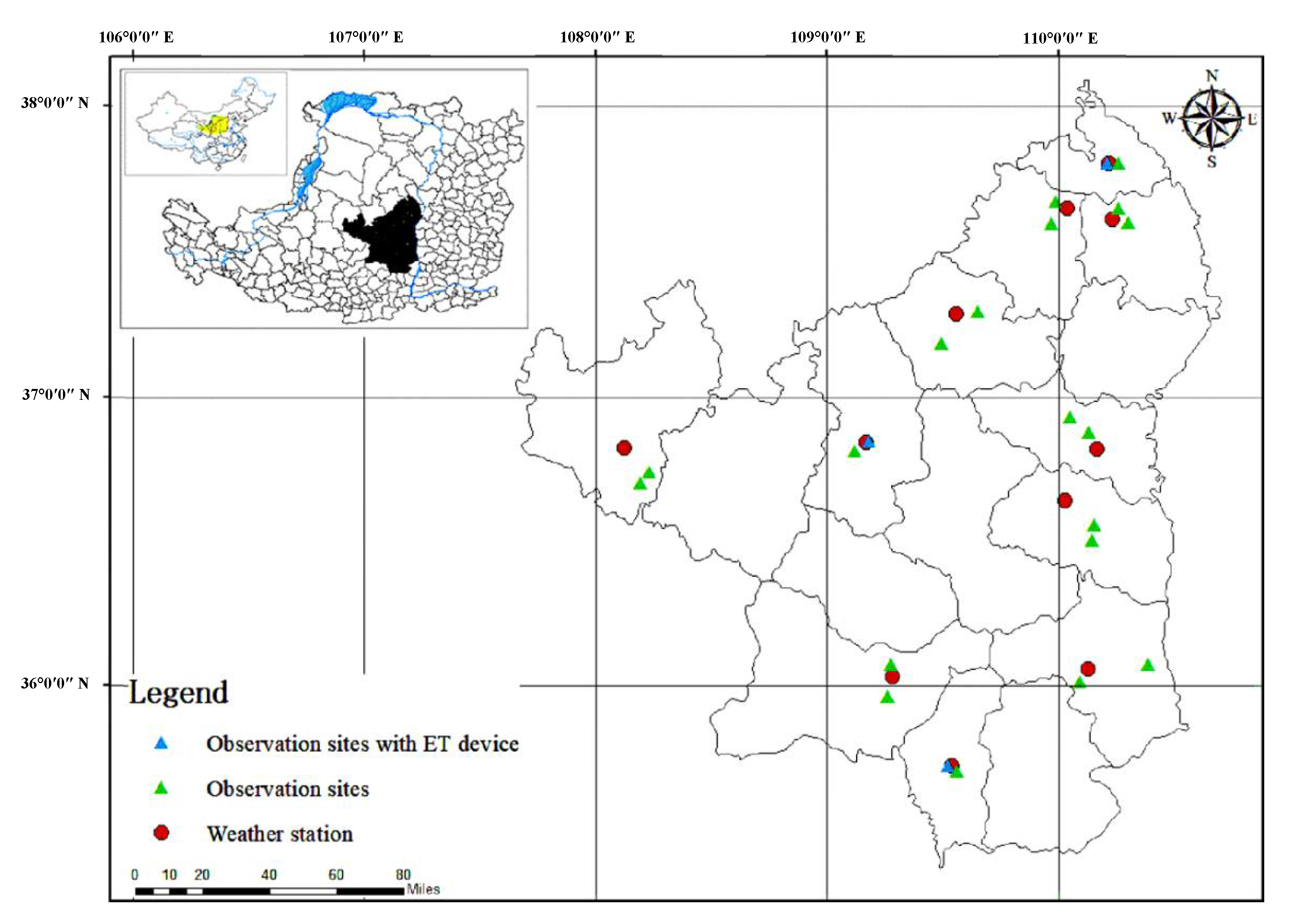
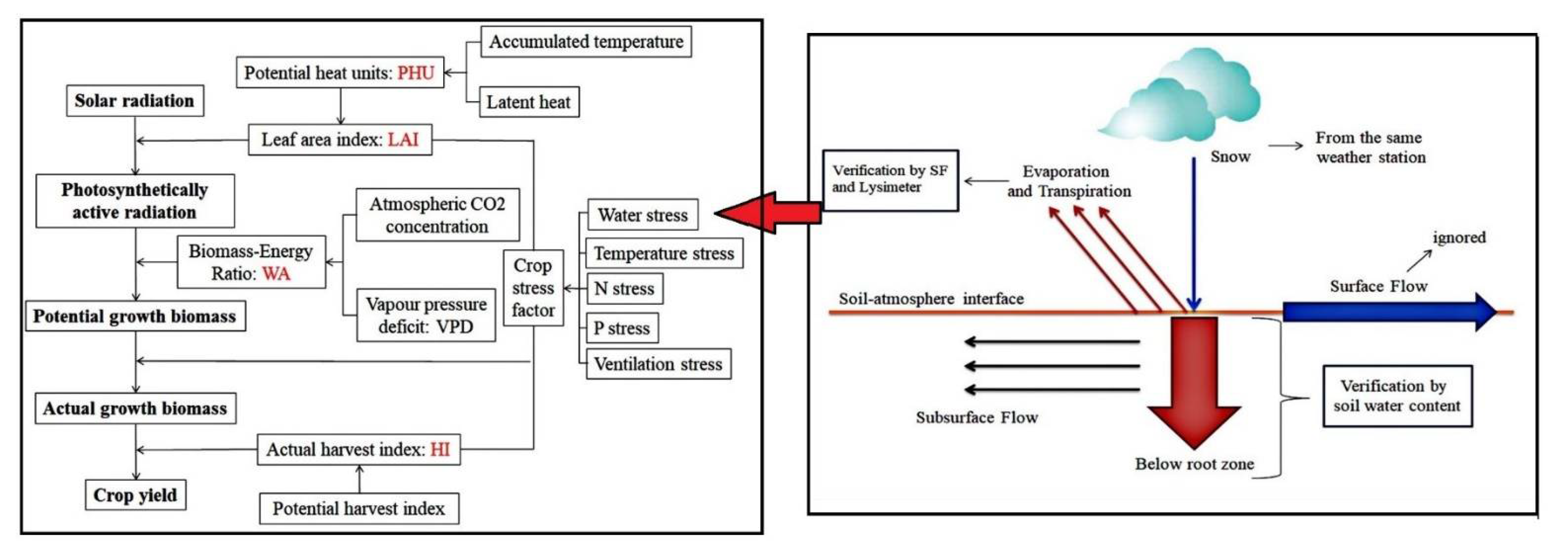

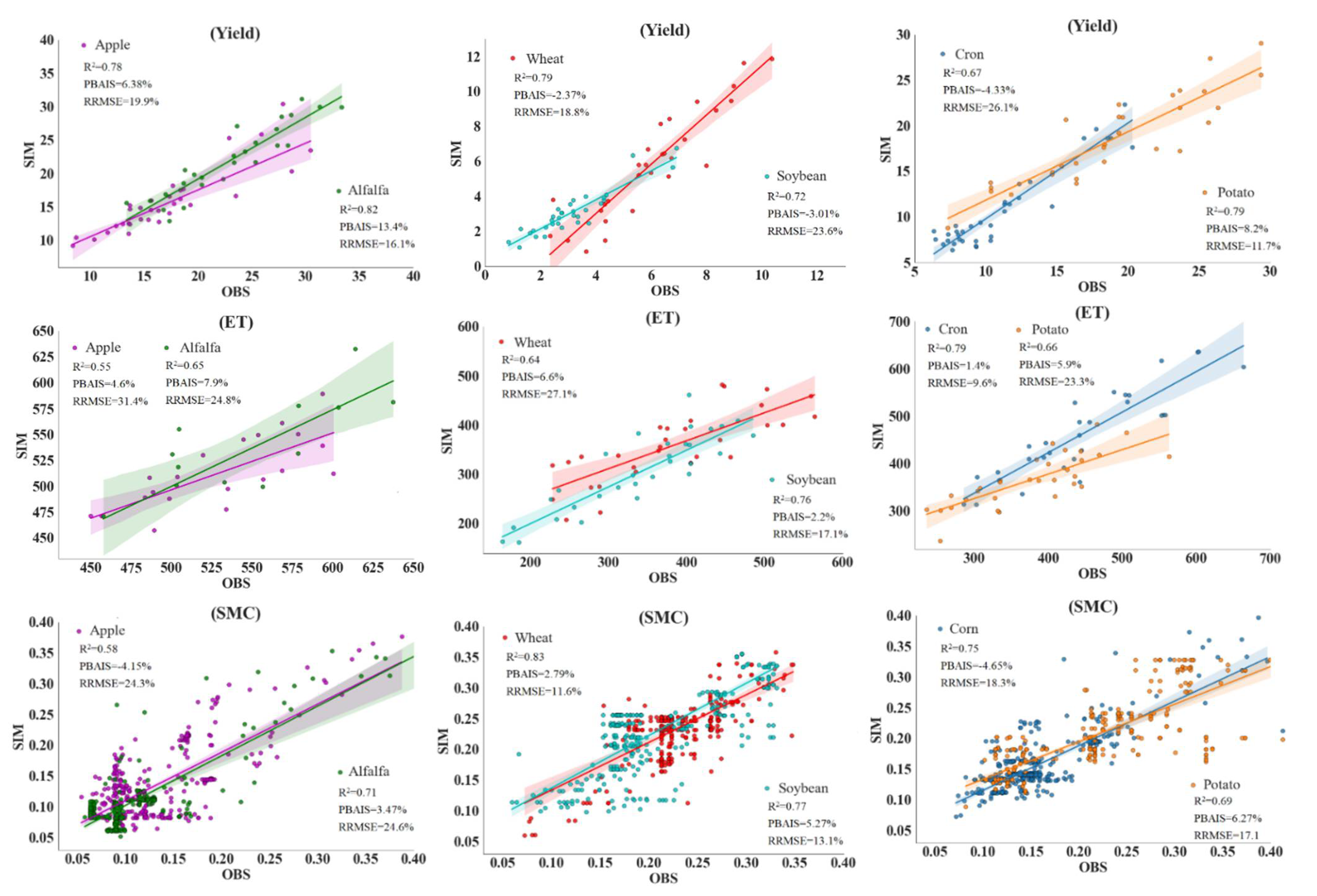
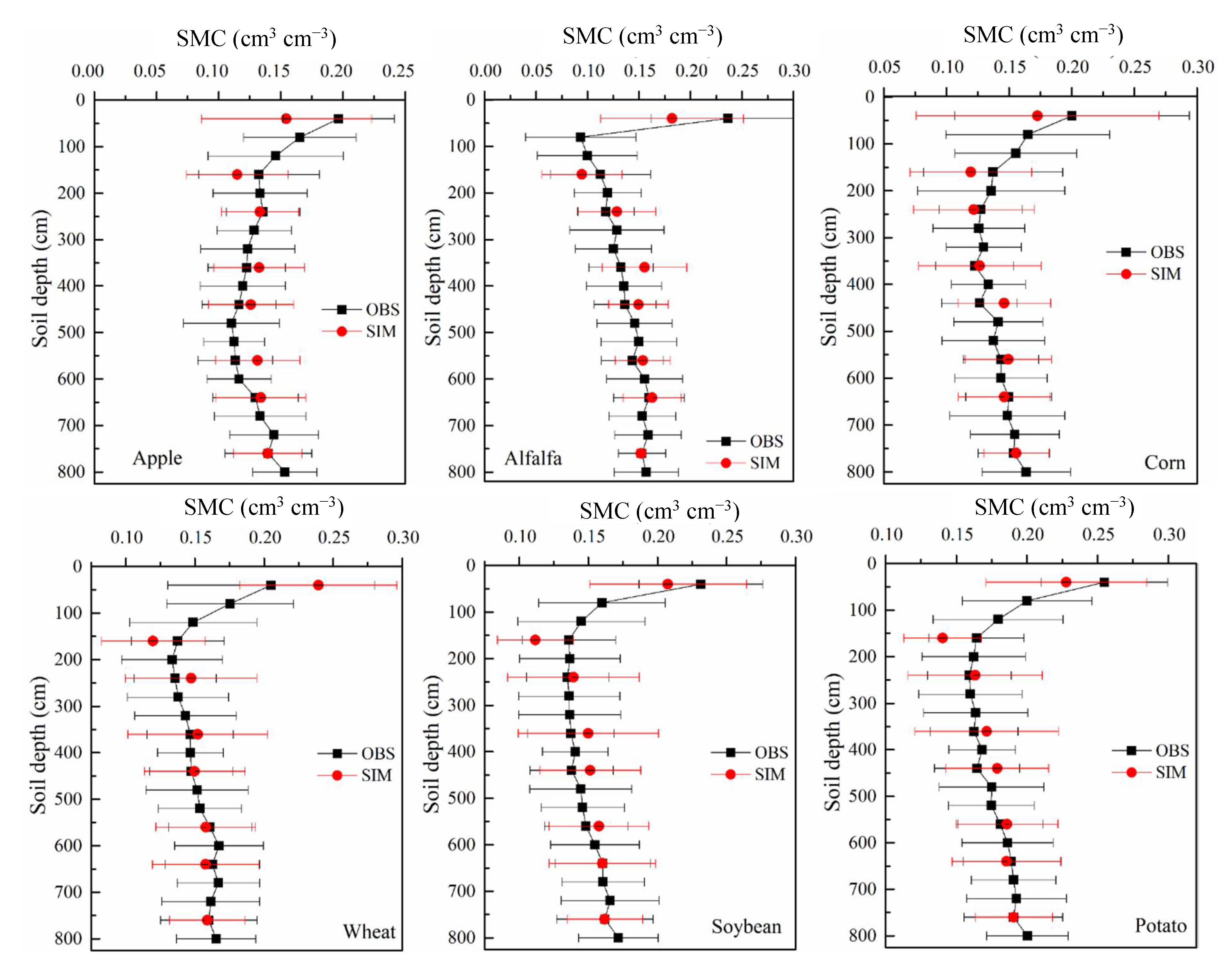


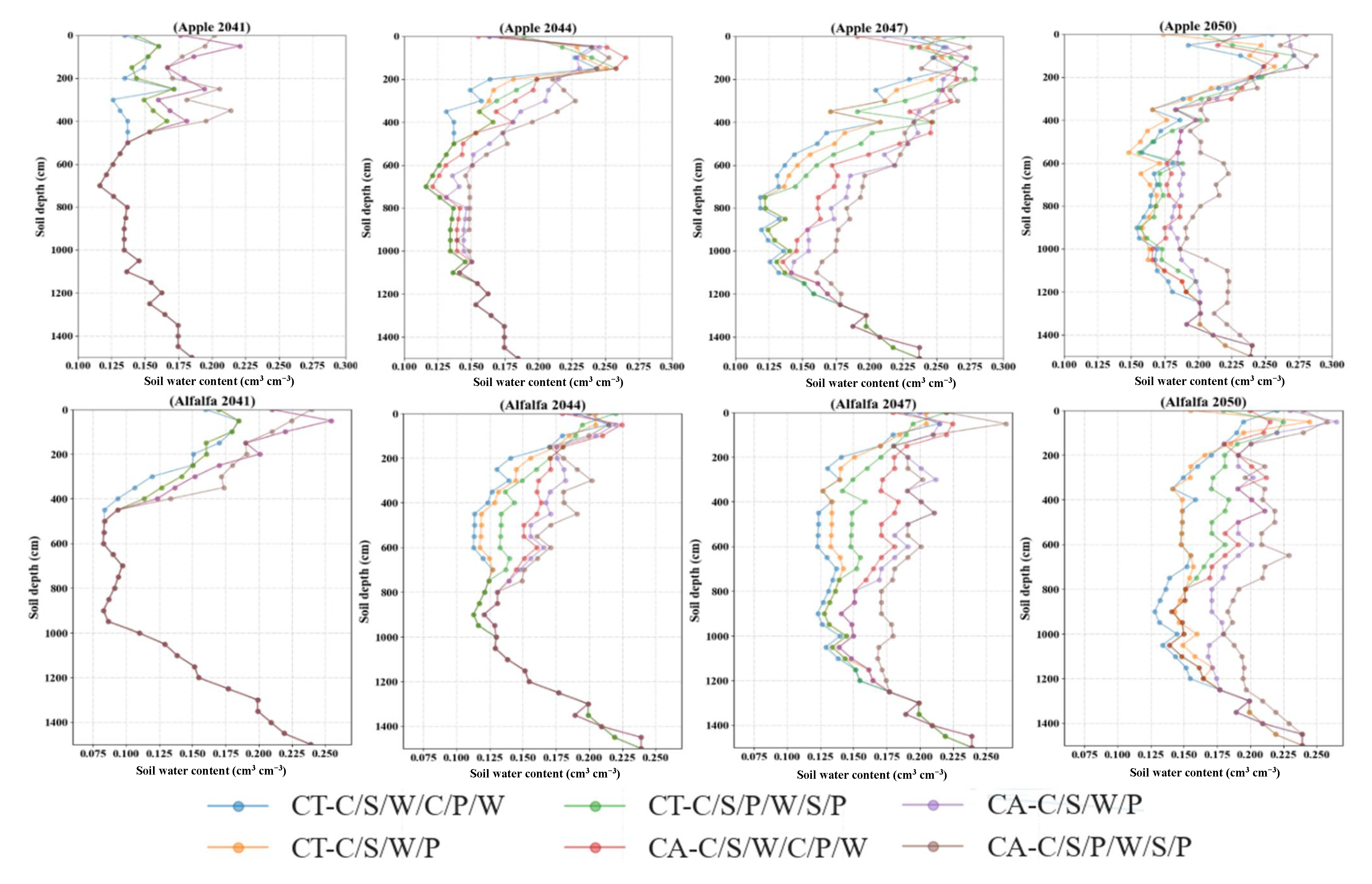
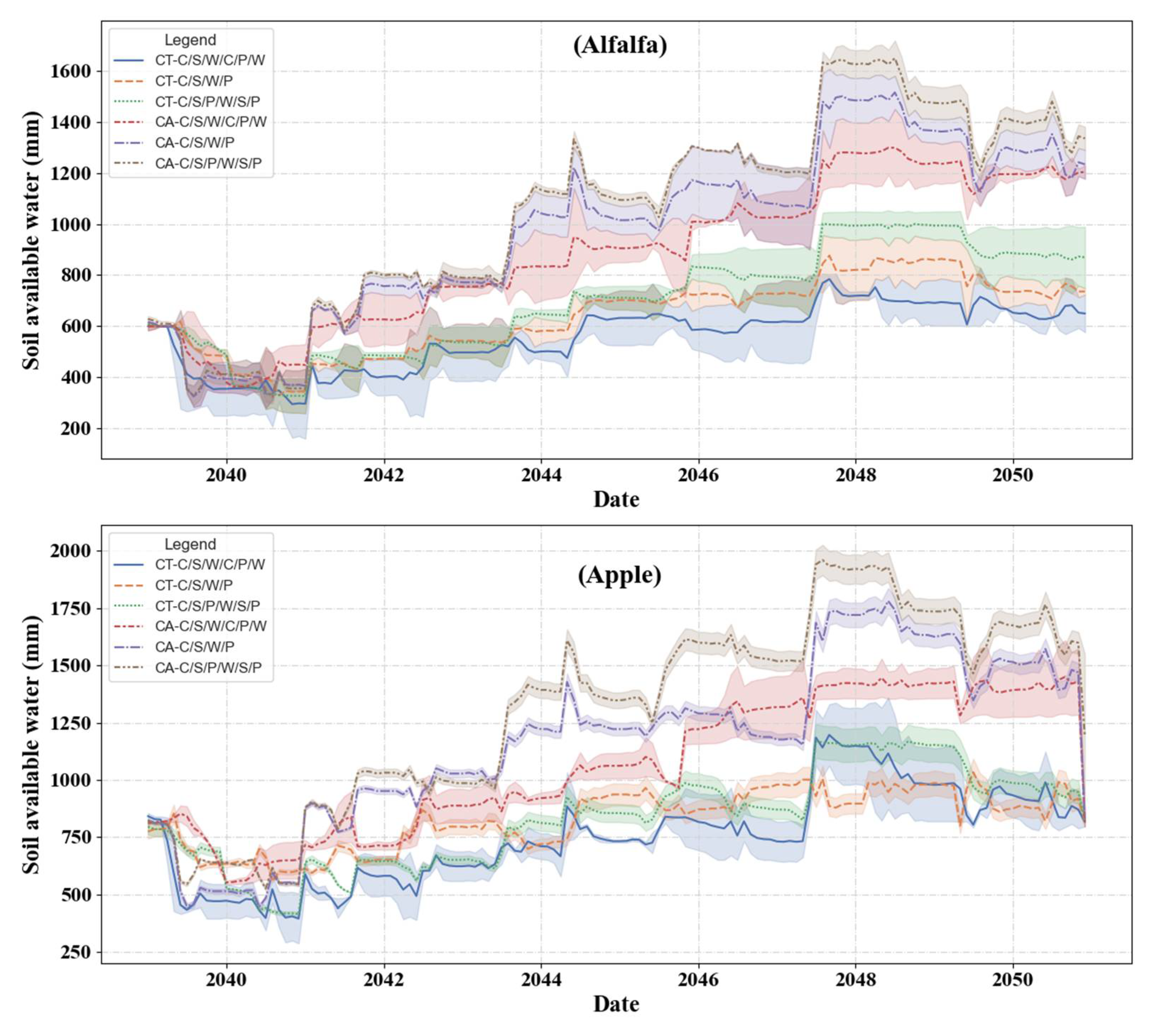
| Combination | Abbreviation | |
|---|---|---|
| Conventional tillage | Cron-Soybean-Wheat-Cron-Potato-Wheat*2 | CT-C/S/W/C/P/W |
| Cron-Soybean-Wheat-Potato*3 | CT-C/S/W/P | |
| Cron-Soybean-Potato-Wheat-Soybean-Potato*2 | CT-C/S/P/W/S/P | |
| Conservation agriculture | Cron-Soybean-Wheat-Cron-Potato-Wheat*2 | CA-C/S/W/C/P/W |
| Cron-Soybean-Wheat-Potato*3 | CA-C/S/W/P | |
| Cron-Soybean-Potato-Wheat-Soybean-Potato*2 | CA-C/S/P/W/S/P |
| NO | Parameter | Symbol |
|---|---|---|
| 1 | Biomass-energy ratio (kg ha−1 MJ−1 m−2) | WA |
| 2 | Harvest index | HI |
| 3 | Maximum potential leaf area index. | DMLA |
| 4 | Fraction of growing season when LAI starts to decline | DLAI |
| 5 | Nitrogen uptake—Nitrogen fraction at 0.5 maturity | BN2 |
| 6 | Adjust crop canopy resistance in the Penman–Monteith EQ | PARM (1) |
| 7 | Governs rate of soil evaporation from top 0.2 m of soil | PARM (12) |
| 8 | Power of change in day length component of LAI growth | PARM (70) |
| 9 | Penman–Monteith adjustment factor | PARM (74) |
| 10 | Harvest index adjustment for fruit and nut trees | PARM (76) |
| 11 | Bulk Density(moist) of soil layer (t cu. M−1) | BD |
| 12 | Wilting Point (m m−1) | WP |
| 13 | Field Capacity (m m−1) | FC |
| Index | Parameter | APPLE | Alfalfa |
|---|---|---|---|
| Water productivity (kg cm−3) | Maximum | 5.21 | 5.43 |
| Minimum | 0.63 | 1.04 | |
| Average | 2.57 | 3.03 | |
| Standard deviation | 0.92 | 0.94 | |
| Coefficient of variation (%) | 35.9 | 30.86 | |
| Yield loss | Maximum | 0.76 | 0.88 |
| Minimum | 0.07 | 0.08 | |
| Average | 0.32 | 0.40 | |
| Standard deviation | 0.18 | 0.23 | |
| Coefficient of variation (%) | 57.1 | 57.4 | |
| Soil available water (mm) | Maximum | 1580 | 1654 |
| Minimum | 556.9 | 509.6 | |
| Average | 949.6 | 788.2 | |
| Standard deviation | 160.6 | 192.0 | |
| Coefficient of variation (%) | 16.9 | 24.4 |
Publisher’s Note: MDPI stays neutral with regard to jurisdictional claims in published maps and institutional affiliations. |
© 2021 by the authors. Licensee MDPI, Basel, Switzerland. This article is an open access article distributed under the terms and conditions of the Creative Commons Attribution (CC BY) license (https://creativecommons.org/licenses/by/4.0/).
Share and Cite
Guo, F.; Wang, Y.; Wu, F. Conservation Agriculture Could Improve the Soil Dry Layer Caused by the Farmland Abandonment to Forest and Grassland in the Chinese Loess Plateau Based on EPIC Model. Forests 2021, 12, 1228. https://doi.org/10.3390/f12091228
Guo F, Wang Y, Wu F. Conservation Agriculture Could Improve the Soil Dry Layer Caused by the Farmland Abandonment to Forest and Grassland in the Chinese Loess Plateau Based on EPIC Model. Forests. 2021; 12(9):1228. https://doi.org/10.3390/f12091228
Chicago/Turabian StyleGuo, Fuxing, Yanping Wang, and Fuyong Wu. 2021. "Conservation Agriculture Could Improve the Soil Dry Layer Caused by the Farmland Abandonment to Forest and Grassland in the Chinese Loess Plateau Based on EPIC Model" Forests 12, no. 9: 1228. https://doi.org/10.3390/f12091228
APA StyleGuo, F., Wang, Y., & Wu, F. (2021). Conservation Agriculture Could Improve the Soil Dry Layer Caused by the Farmland Abandonment to Forest and Grassland in the Chinese Loess Plateau Based on EPIC Model. Forests, 12(9), 1228. https://doi.org/10.3390/f12091228






